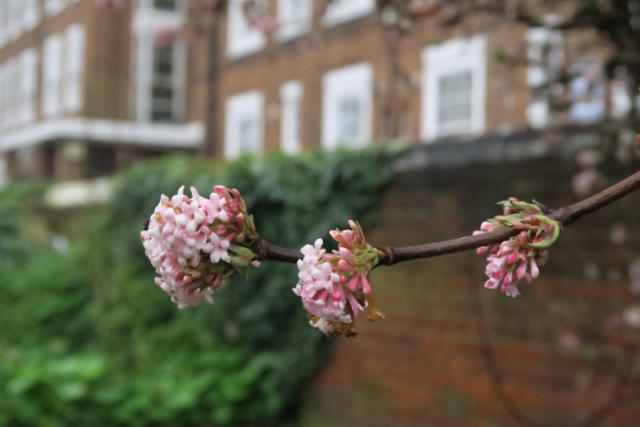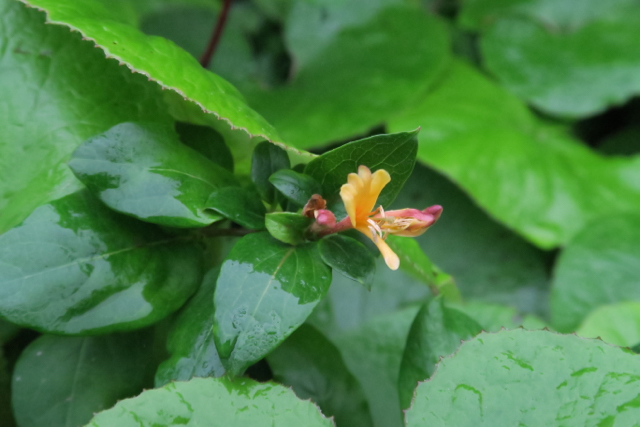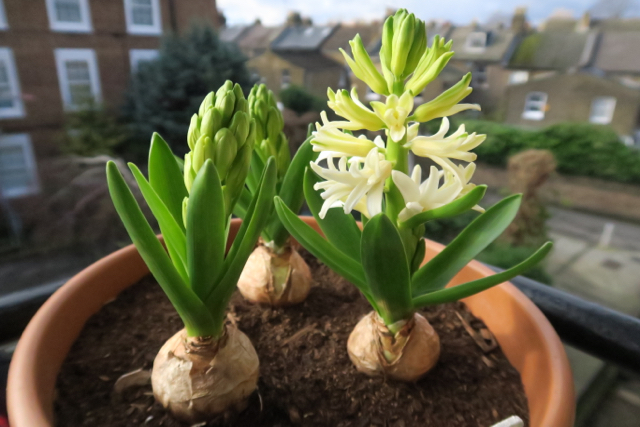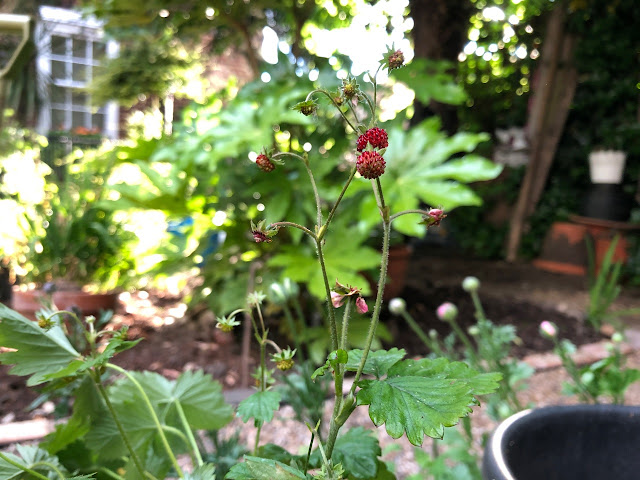 |
| Good things in small packages - sitting in the sun this morning, watching this bumblebee forage. |
This past week the garden has been a welcome relief from all the doom and gloom of the coronavirus outbreak (currently 22 cases in my home borough of Camden). It’s been really heartening to see plants bursting into life, a good distraction from the scary turmoil in the outside world.
The gardens that I look after here have always provided a place of peace, calm and sanctuary for me - yes, even with slugs, aphids, and foxes - and I’m grateful that I’m able to work outside in the fresh air, listen to birdsong, watch plants grow and think about the seasons ahead. (Especially important as I live in a second floor flat and am otherwise surrounded by bricks, mortar and concrete. Urban living!)
It also feels very relevant to have a space to grow food in these uncertain times and the weather feels warm enough to start sowing. I’ve started several more trays of micro leaves - lettuce, herbs, salad leaves - on my balcony and this week will sow tomatoes and chillies indoors plus peas, carrots, spinach and more broad beans outside.
Speaking of broad beans, the plants that I sowed into modules last November and planted out in December are now flowering! Having never overwintered broad beans before, I don’t know if this is unusual or early thanks to a mild winter, but it’s pretty thrilling. Such are the simple things that please me.
A neighbour kindly gave me a couple of brassicas last summer. Unsure of exactly what they were, I thought they would look pretty among the perennials in the car park garden. Turns out that they’re Purple Sprouting Broccoli - quite small as they were probably in modules for too long, but they’re definitely sprouting.
As is the blossom on the plum tree. I noticed this fragile flower as I wandered the garden in a fairly forceful wind; I don’t reckon its chances much but at least there will be more blossom to follow, this time I hope in sunshine. The weather this week looks very promising. (And bumblebees are foraging, see top photo taken this morning. That bee eventually buzzed off towards the plum blossom.)
And, finally, some good/bad/good news. Last weekend I cleaned up an unused south facing paved space thinking it would be perfect for growing sun loving veg. The next day I spotted several empty but used Veg Trugs outside a closed down day care centre and was given permission by the owners to take them for my new space. Hurrah! I thought. But the following day someone had stolen the best ones, leaving only those that had seen much better days. I won’t repeat what I said at the time, suffice to say that my faith in human nature plummeted.
But, undeterred, as is my nature, I contacted Veg Trug. They had already very kindly offered to donate new liners for the abandoned trugs - I explained what had happened and asked whether they would let me have a discount on buying a couple of new Veg Trugs? (I babysit to fund the gardens here.) Within the hour, the answer was yes. And, sometime today, two beautiful new Veg Trugs will be delivered for my new community space.
But that’s not all. Friends went to collect the remaining old Veg Trugs and their carpenter son has said he’ll replace and rebuild the trugs for me. This is why I love living where I do, the community here can be so supportive and kind. Two very important traits in today’s world.
I hope that story has left you all with some optimism for the times we live in. Safe to say that during this virus pandemic, I am concerned about my family and friends, particularly as they're so far away. So I'm wishing you all good health, staying safe and virus free; remember to wash your hands, take vitamin C, think of the people around you and grow some greens, even if that's just pea shoots in a pot on your doorstep or balcony.
Caro xx
It also feels very relevant to have a space to grow food in these uncertain times and the weather feels warm enough to start sowing. I’ve started several more trays of micro leaves - lettuce, herbs, salad leaves - on my balcony and this week will sow tomatoes and chillies indoors plus peas, carrots, spinach and more broad beans outside.
Speaking of broad beans, the plants that I sowed into modules last November and planted out in December are now flowering! Having never overwintered broad beans before, I don’t know if this is unusual or early thanks to a mild winter, but it’s pretty thrilling. Such are the simple things that please me.
 |
| Ridiculously excited at the sight of those purple buds |
A neighbour kindly gave me a couple of brassicas last summer. Unsure of exactly what they were, I thought they would look pretty among the perennials in the car park garden. Turns out that they’re Purple Sprouting Broccoli - quite small as they were probably in modules for too long, but they’re definitely sprouting.
 |
| The plum trees are the first to blossom, but the pears are not far behind |
As is the blossom on the plum tree. I noticed this fragile flower as I wandered the garden in a fairly forceful wind; I don’t reckon its chances much but at least there will be more blossom to follow, this time I hope in sunshine. The weather this week looks very promising. (And bumblebees are foraging, see top photo taken this morning. That bee eventually buzzed off towards the plum blossom.)
 |
| It doesn't look much now but watch this space! |
But, undeterred, as is my nature, I contacted Veg Trug. They had already very kindly offered to donate new liners for the abandoned trugs - I explained what had happened and asked whether they would let me have a discount on buying a couple of new Veg Trugs? (I babysit to fund the gardens here.) Within the hour, the answer was yes. And, sometime today, two beautiful new Veg Trugs will be delivered for my new community space.
But that’s not all. Friends went to collect the remaining old Veg Trugs and their carpenter son has said he’ll replace and rebuild the trugs for me. This is why I love living where I do, the community here can be so supportive and kind. Two very important traits in today’s world.
I hope that story has left you all with some optimism for the times we live in. Safe to say that during this virus pandemic, I am concerned about my family and friends, particularly as they're so far away. So I'm wishing you all good health, staying safe and virus free; remember to wash your hands, take vitamin C, think of the people around you and grow some greens, even if that's just pea shoots in a pot on your doorstep or balcony.
Caro xx














































